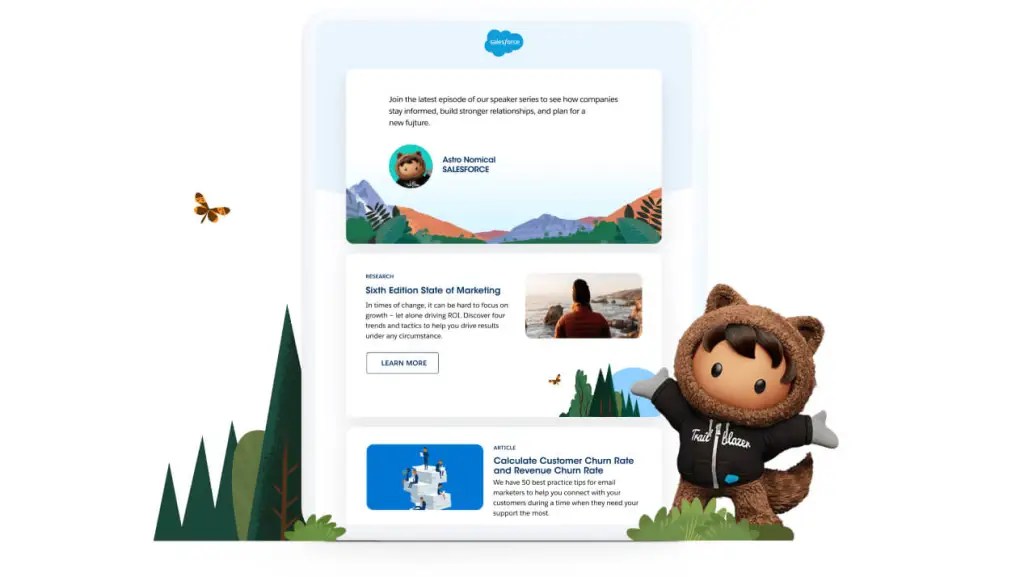Have you heard of “awareness” in the marketing context, but aren’t quite sure what it means? This article will explain the concept of brand awareness and its crucial role in the sales funnel. We’ll explore why it’s essential for your company and how it can impact your success.
What is brand awareness?
Brand awareness is how familiar people are with your business, products, or services. Awareness ensures your brand comes to mind first, especially when someone is choosing between you and a competitor. You want to meet potential customers before they are even aware they have the problem you can solve.
For marketers, awareness comes before demand. When people know who you are and what you offer, they’re more likely to trust you, and that trust is what turns brand recognition today into sales tomorrow. Keep in mind, awareness is a long game. But without it, your sales may start to flatline once you’ve exhausted the market of people actively searching for what you offer.
See the top trends in data, AI, and more — from nearly 5,000 marketers worldwide.

Brand awareness vs. brand recognition
Brand recognition is when someone sees your logo or name and knows who you are. Brand awareness is a marketing practice focused on being present in your customer’s orbit before they’re even thinking about making a purchase.
Awareness builds memory and trust with your audience. Perhaps they took a course or read a helpful e-book you published. Now, when they are ready to buy, your brand is the one that comes to mind first. If you want to grow future demand, awareness is what keeps your business growing long after your initial boom.
Why brand awareness matters
Brand awareness is what gets your brand in the room before your customer is even ready to buy. It matters because familiarity builds trust, people are more likely to choose a brand they’ve seen before. It also drives sales over time. If your brand comes to mind first, you’re in a better position when they’re finally ready to make a decision.
While short-term tactics drive immediate sales, brand awareness lays the foundation for long-term growth. Once people already know who you are, lead generation gets easier. Customers are warmer, more curious, and often come to you.
If you’re only chasing in-market buyers, you’ll eventually hit a ceiling. Awareness is how you grow beyond that.t, helping the public in decision-making.
Build lasting relationships that drive growth with Marketing Cloud.
Action all your data faster with unified profiles and analytics. Deploy smarter campaigns across the entire lifecycle with trusted AI. Personalise content and offers across every customer touchpoint.



Key Components of Brand Awareness
Brand awareness isn’t about flashy campaigns or quick wins. It’s about building memory. The goal is to be the brand people think of first, without needing a reminder, when they’re ready to buy. That kind of familiarity doesn’t happen overnight, it’s built slowly by showing up consistently.
Brand recognition
This is the first layer of your brand. It’s when someone sees your logo, a colour, a tagline, and instantly knows it’s you. Recognition builds through consistency. If someone can spot your brand in a crowd of competitors, you’re already ahead. Think the hardware store with the sausage sizzles or the drink you have with lime.
Brand recall
A layer down is when someone thinks of your brand without seeing it, but just by thinking about the category. It means your brand has taken up space in their memory, like hearing “active-wear” and immediately thinking of Nike or Lululemon.
Top-of-mind awareness
This is the real brand battleground. It’s when your brand is the first one that comes to mind. That’s where the majority of purchase decisions happen. People tend to default to what is most mentally available. Think of wanting a smoothie and immediately picturing how far you are from your nearest Boost Juice.
Brand dominance
This is the goal. You’ve become the automatic answer. Not just the first brand people think of, but the only one. Like Google, Uber, or Zoom. In crowded markets, dominance comes from years of consistent, memorable brand building. It’s earned, long before someone clicks “buy.”
Strategies to boost brand awareness
While brand awareness can sometimes take the form of big activations or viral moments, that’s not the point. Brand awareness is always about the long game and consistency. With that in mind, here are some practical ways to get started.
Become instantly recognisable
Make sure your visuals, tone, and messaging are aligned everywhere your brand shows up. You want customers to see the shape of your logo or your colours and know it’s you. When your brand is easier to recognise, it’s easier to remember.
This extends beyond your brand’s appearance and encompasses how you interact with your customers. For example, the popular employment marketplace SEEK started using Salesforce to consolidate its customer data, which has enabled their team to deliver a more consistent brand experience across their sales, marketing, and service channels.
Make campaigns people can’t help but share
The best brand campaigns don’t talk about their products or services. They make people feel something. A good campaign either tells a story, taps into a cultural moment (thoughtfully and appropriately), or gives people something they want to share.
Focus on emotion, relevance, and simplicity. If your campaign feels human, relatable, and memorable, it’s more likely to stick in people’s minds and build the kind of memory that drives future buying decisions.
Show up where your customers already are
You can’t build awareness if your potential customers rarely see you. Make sure you’re active on the platforms your customers use. You can find this out by doing some customer interviews and asking them where they spend their digital time.
In these spaces, reply to comments, reshare user content, and be part of conversations without selling your product. The more often people see your brand in a helpful, natural way, the more you become a friendly, familiar face. For example, L’Oréal Australia uses Salesforce Social Studio to jump into online beauty conversations and engage with the community in real-time, helping the brand stay top of mind.
Win trust with content marketing before selling
Content is all about being useful to your audience. Focus on creating simple, valuable content that helps solve real problems for your audience. Consider quick guides, how-tos, tips, or templates. The goal at this stage isn’t to sell, it’s to build credibility so that when someone does have a need, your brand is already the one they trust.
Grow your reach with PR and partnerships
Positive media coverage and smart partnerships can help you reach audiences you might not otherwise connect with. The key is to choose partnerships and sponsorships that align with your brand and feel genuine.
It’s not about being everywhere. You want to be seen in the right places, in a way that builds trust and credibility with new audiences. For example, if you are selling to engineers, it might be beneficial to partner with the local association.
When should your business focus on brand awareness?
If you’re serious about long-term growth, brand awareness can’t be an afterthought. It needs to be part of your strategy from day one.
You’ll want to consider brand awareness when you’re launching something new, entering a new market, or repositioning yourself against your competitors. You can’t just rely on people to find you. You have to actively build recognition before customers are ready to buy.
If you’re seeing flat or declining sales, awareness is how you reach new audiences and stay in the game when the immediate demand dries up. It also plays a critical role when you’re rebranding, you’re not just changing the logo, you’re rebuilding trust from the ground up.
The businesses that win are the ones that stay memorable over time. If you want to grow future demand, protect your market share, or make sure customers think of you first, brand awareness is a step you can’t afford to skip.
Stay up to date on all things marketing.
Sign up for our newsletter to get the latest research, industry insights, and product news delivered straight to your inbox.

How do you measure brand awareness?
Brand awareness is about making sure your brand actually sticks in the minds of your customers, not just getting lots of impressions on social media. You want your ideal customer to remember you.
It is notoriously difficult for marketers to measure awareness. However, there are still a few practical ways to gauge if your awareness marketing is working. Here are five ways.
Website traffic (especially direct and branded search)
If more people are typing your brand name into Google or going straight to your site, that’s a sign you’re building recognition. Track direct traffic and branded search terms over time.
Social media engagement
Look beyond how many likes your posts get. Focus on comments, shares, and mentions. These show your brand is not just seen but being talked about.
Brand mentions and share of voice
Use social listening to see how often your brand is coming up in conversations compared to others in your space.
Surveys and brand lift studies
Sometimes the clearest way to measure awareness is to ask your customers directly. Run quick surveys or brand studies to check if your marketing is making a lasting impression.
Search interest over time
Use tools like Google Trends or Google Keyword Research to see if more people are searching for your brand month after month.
Tracking elements regularly will give you a clearer picture of what’s working and what you might need to tweak to keep building momentum.
Summing up
Brand awareness is about giving your future customers a reason to remember you, long before they’re ready to buy. If you want to keep growing future demand, you need to show up consistently, build trust early, and stay top of mind. It takes time, but it’s what sets growing brands apart from the ones that eventually stall.
If you’re ready to build a smarter, stronger brand across all your channels, Salesforce Marketing Cloud can help you show up before your customers even know they need you.
FAQs
What types of brand awareness should I measure?
There are a few different types of brand awareness. Here are the three most common:
- Unaided brand awareness: People can name you without any help.
- Aided brand awareness: They recognise you from a list of brands in your category,
- Top-of-mind awareness: You’re the first brand that comes to mind.
Each layer represents a different cognitive process in your ideal customer’s mind. If you want to increase brand awareness and build real customer loyalty, focus on all three. Strong brand awareness and brand recall puts you ahead in the decision-making moment.
How does building a strong brand help with long-term growth?
Building a strong brand does more than drive sales today. It builds brand equity and keeps your name top of mind a years from now.
A positive brand experience today boosts your brand reputation, strengthens customer loyalty, and increases your spot in the consideration set.
The earlier you invest in brand marketing and brand advertising strategies, the easier it becomes to grow your audience, no matter if you’re operating in Australia, the United Kingdom, or anywhere else. Long-term success starts with early awareness and brand connection.
What’s the best way to track your brand awareness over time?
The best way to track your brand awareness is to set a few key awareness metrics and measure them regularly, things like direct website traffic, branded search volume, brand awareness surveys, and social mentions. Watch for long-term trends, not just spikes.
What are some examples of brands with strong brand awareness?
Brands like Amazon and Nike are classic examples of brands that have built strong brand awareness by showing up consistently across every channel. Their brand assets (logos, slogans, visuals) stay true no matter the platform, and their marketing communication is always clear about their brands values.
They’ve mastered brand management by focusing not just on their brands products, but also on building emotional loyalty through great customer experiences and employee engagement. That’s what creates lasting brand loyalty.
How can you measure the impact of brand awareness campaigns?
The best way to measure the impact of your brand awareness campaigns is through a mix of brand tracking, online surveys, web traffic analysis, and monitoring your net promoter score.
You can also watch for increased awareness by looking at social engagement spikes, better public relations mentions, and growth in unaided awareness, where customers recall your brand without any prompting.
Tracking real shifts in brand perception and customer brand attitudes gives you a better read on how your awareness strategies are influencing consumer behaviour over time.























